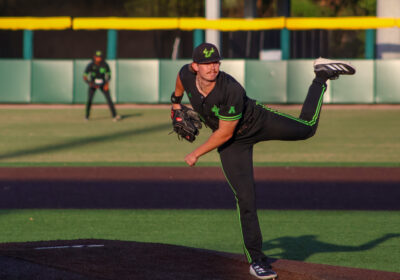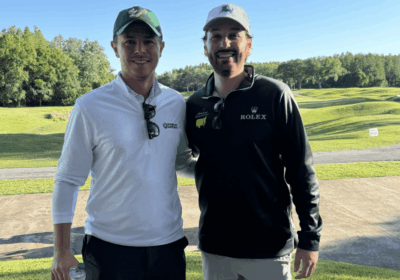Former WNBA President Orender gives insight into gender in sports

Former WNBA President and business executive Donna Orender spoke at USF's Sports and Entertainment Management Lecture Series Thursday evening. ORACLE PHOTO/JACOB HOAG
An innovator, a motivator and a portrait of ambition, she transcends the playing surface to provide a fresh look on gender equality.
In a domain overrun by men, former six-sport athlete and Women’s Basketball League (WBL) star turned business executive Donna Orender holds the power of the ball, in this case a basketball, firmly in her grasp.
“For me, I don’t know about you, but for me, this ball is a game-changer. Not only for me, but for girls and for women and boys like my son,” said Orender, who spoke at the USF Sports and Entertainment MBA Lecture Series Thursday night. “As a young female athlete, if I wanted to be in the game, I’d best be carrying around my ball.
“What I love about this ball in particular is that it dances and it sings. And it represents for me, and for all of us, an incredible strength of human spirit. It embodies values.”
A ball brings out every emotion — good or bad, ugly or inspiring — in every person across the spectrum. For Orender, the ball represents struggle and perseverance to achieve greatness and equality.
Before Orender became one of the only 20 women to play in all three seasons of the WBL’s short history and rose to become one of the top 10 women in sports, she crashed through gender barriers as a young girl in Long Island, New York.
“My first sport was not basketball. I came to love that when I was 14,” said Orender, the former President of the WNBA. “Before that, I wanted to play tennis. It was a time when Christine Evert was running around in her beautiful, white flouncy uniform and my grandma said I could (play).”
She decided she wanted to play on her high school team, but a wall stood in her way.
“I couldn’t play on our team. There was no girls’ team,” Orender said.
This didn’t slow her down in the slightest. If anything, it spurred her to push the limits.
“I decided I would go to the boys’ tennis coach,” Orender said. “Keep in mind, there had never been a girl to play on a boys’ team anywhere, and certainly not in the state of New York where I grew up.”
The easy answer was no. But instead, the coach surprised her with an answer she didn’t expect.
“He said, ‘If you want to be on this team, you have to earn your way.’ He could’ve cited any high school rule, but he didn’t. He gave me an opportunity,” Orender said.
Orender took that opportunity and earned her varsity letter. Orender also lettered in volleyball, field hockey, softball and tennis before going on to play college basketball.
Attention was not something she craved, but felt she deserved. It was something the boys’ sports got, but never amounted to much for the girls.
“What did the boys have in school? The boys had this incredible platform where they got so much attention,” Orender said gazing out at a half-full Oval Theater. “They were written about in newspapers, schools were chasing them for scholarships and they were adored.”
“People actually came to their games as opposed to the six, including my parents, that came to ours. There was a sense of power there.”
There’s no question that gender plays a role in sports. Male sports bring in the money, the sponsors and the ratings, but in Orender’s eyes, talent is what should matter, not gender or race.
“Talent should be celebrated no matter who puts it out on the court.”
Putting those words into action, though, is a difficult task.
“There’s a gender divide,” Orender said of the sports world. “There are behavioral differences, there are social and cultural differences, there are people of different color, people of different backgrounds. All of these contribute to what all of us possess: the bias that we all have.”
Not even a person so involved and entrenched in the advancement of women could escape the bias engrained in society.
“I’m with a women’s networking business group on a golf trip to Colorado, doing this great work for the golf industry,” Orender said. “So I thought we’d go into the golf shop and I could kind of show how I am totally integrated and I know everybody.
“So I go in and ask for the pro and they introduce me to this woman who’s hanging up shirts. We talk for a bit and then I say to her, ‘So where’s the head pro?’ She goes, ‘I am the head pro.’”
But it wasn’t her fault. Orender said it’s the way gender is portrayed in sports media that teaches kids at a young age what is important and what falls by the wayside.
ESPN, the nation’s “leader” in sports, fails to set a positive example when it comes to women’s sports, Orender alluded.
“ESPN is a bellwether,” Orender said. “It tells us, whether we want to hear it or not, what is important. It determines our priorities as long as we let it. If it’s 16 minutes of baseball and 20 minutes of football, then guess what we think is important?”
During a year’s worth of coverage on its flagship show “SportsCenter,” only two percent of its coverage dealt with women’s sports. A prime example is one of the world’s most beloved and televised athletes.
“There was a woman — brazen and bold — and she stood up and she said, ‘You know what? I play basketball and I don’t care about the NBA; I want to watch LeBron,’” Orender said reminiscent of a woman she met a few years back at an ESPN sponsored event. “I said of course you want to watch LeBron … aside from being an amazing physical specimen, if you look at how many times he’s on national television, I think it’s more than any other player … ESPN really does determine our watercooler talk.”
But times are slowly changing.
Orender spoke about watching the New York Giants’ — her hometown team — Ticker-Tape Parades following their Super Bowl win over the New England Patriots in 2012. She watched the admiration of the fans as the confetti fell from the sky and wondered if she’d ever see a women’s team get a celebration of that magnitude.
“And then, there’s 2015 and there’s the Ticker-Tape and there is the (U.S.) Women’s World Cup champion soccer team,” Orender said. “The Ticker-Tape was all around and I said, ‘You know what? The times are changing.’ This told not only young girls, but young boys that (women) can compete and are worthy of our affection, our time, our dollar and our heart.”
The viewing statistics for the 2015 World Cup Final was 28 million. In contrast, only 18 million people watched Steph Curry and the Golden State Warriors knock off LeBron and the Cleveland Cavaliers in Game 6 of the 2015 NBA Finals.
A change of the tide.
“The ball speaks every language. It doesn’t know the gender of the hands that holds it … but it does speak male and it does speak female,” Orender said. “For most of us, you don’t have to be an elite athlete to feel the power of ball.”







